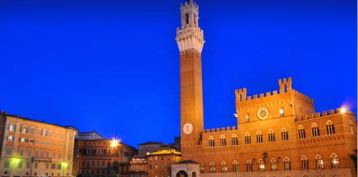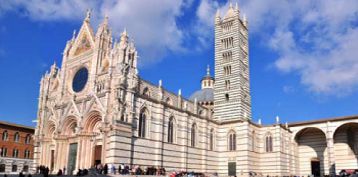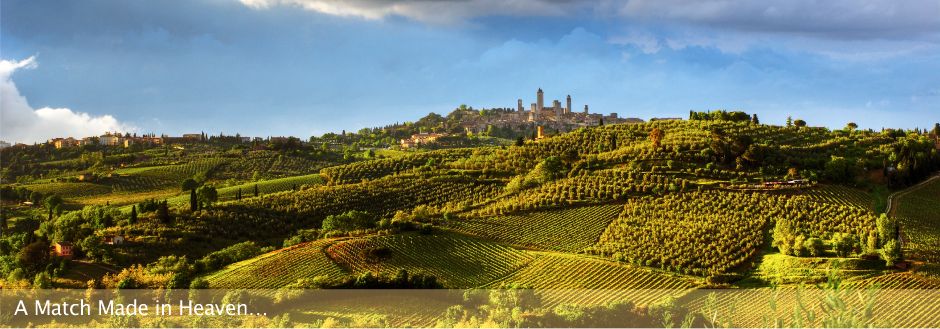| Wedding planner | Settings | Ceremonies | Locations | Services | Wedding guests | Lodgings | Reviews | Contacts |
Locations
Our locations are a selection of medieval hilltop towns in Tuscany Italy adorned with incredible art treasures and surrounded by spectacular natural landscapes. Our philosophy is to avoid big chaotic towns in order to soak up the magic atmosphere of local villages and charming small towns.
The natural setting of your wedding will be the gorgeous Tuscan countryside, where you can enjoy the peace and the tranquillity of this much sought after region.
Siena
 Siena is famous all over the world for its cultural heritage and for the integrity and medieval atmosphere of the town. Its well-preserved historical centre is full of art treasures, beautiful churches and imposing palaces, and it is registered in the list of UNESCO's World Cultural and Natural Heritage since 1995. Its original shell-shaped square, famous all over the world, is the theatre of a traditional horse race, Il Palio di Siena, a unique event of ancient medieval origins that still has an important social value.
Siena is famous all over the world for its cultural heritage and for the integrity and medieval atmosphere of the town. Its well-preserved historical centre is full of art treasures, beautiful churches and imposing palaces, and it is registered in the list of UNESCO's World Cultural and Natural Heritage since 1995. Its original shell-shaped square, famous all over the world, is the theatre of a traditional horse race, Il Palio di Siena, a unique event of ancient medieval origins that still has an important social value.
HISTORY
Siena, like other Tuscan hill towns, was first settled in the time of the Etruscans (c. 900–400 BC) when it was inhabited by a tribe called the Saina. A Roman town called Saena Julia was founded at the site in the time of the Emperor Augustus. Siena prospered as a city-state, becoming a major centre of money-lending and an important player in the wool trade. In the early 12th century a self-governing commune replaced the earlier aristocratic government. Siena's republic, struggling internally between nobles and the popular party, usually worked in political opposition to its great rival, Florence (this conflict between Ghibellines and Guelphs formed the backdrop for some of Dante's Commedia). During the Renaissance, the Strozzi family ruled over Siena while warring with the infamous Florence.
MAIN FEATURES
Perched on three different hills (322m above sea level), Siena has an excellent position in central Tuscany and it is surrounded by landscaped countryside covered with vineyards, and typical cypress trees. Thanks to its mild climate, and to its cultural and economical development, the town boasts a quality lifestyle among the highest in Italy.
Siena's University, founded in 1240 and famed for its faculties of law and medicine, is still among the most important Italian universities. Another important institute in town is the Monte dei Paschi. This bank, founded in 1472 as a mount of piety, is still active today and it is the oldest surviving bank in the world. The Accademia Musicale Chigiana is a music institute founded by Count Guido Chigi Saracini in 1932 as an international centre for advanced musical studies. During the summer months a series of concerts are held under the title of Estate Musicale Chigiana. Siena is surrounded by a unique natural scenery. The region south of Siena, and in particular Val d'Orcia, was re-written in Renaissance times to reflect the ideals of good governance with a perfect harmony between man and nature, and to create an aesthetically pleasing picture. The region of Crete senesi also offers spectacular views of rolling hills fading in the distance, and the distinctive grey colouration of the clay soil gives the landscape an appearance often described as lunar.
MAIN SIGHTS
 Siena's cathedral (Duomo), begun in the 12th century, is one of the great examples of Italian Romanesque-Gothic architecture. Its main façade was completed in 1380. Inside is the famous Gothic octagonal pulpit by Nicola Pisano (1266–1268), and the labyrinth inlaid in the flooring, traversed by penitents on their knees. Within the Sacristy are some perfectly preserved renaissance frescos by Domenico Ghirlandaio, and, beneath the Duomo, in the baptistry is the baptismal font with bas-reliefs by Donatello, Lorenzo Ghiberti, Jacopo della Quercia and other 15th century sculptors. The Museo dell'Opera del Duomo contains Duccio's famous Maestà (1308–1311) and various other works by Sienese masters. The shell-shaped Piazza del Campo, the town square, which houses the Palazzo Pubblico and the Torre del Mangia, is another architectural treasure, and is famous for hosting the Palio horse race. The Palazzo Pubblico houses yet another important art museum. Included within the museum is Ambrogio Lorenzetti's series of frescos on the bad government and also some of the finest frescoes of Simone Martini and Pietro Lorenzetti.
Siena's cathedral (Duomo), begun in the 12th century, is one of the great examples of Italian Romanesque-Gothic architecture. Its main façade was completed in 1380. Inside is the famous Gothic octagonal pulpit by Nicola Pisano (1266–1268), and the labyrinth inlaid in the flooring, traversed by penitents on their knees. Within the Sacristy are some perfectly preserved renaissance frescos by Domenico Ghirlandaio, and, beneath the Duomo, in the baptistry is the baptismal font with bas-reliefs by Donatello, Lorenzo Ghiberti, Jacopo della Quercia and other 15th century sculptors. The Museo dell'Opera del Duomo contains Duccio's famous Maestà (1308–1311) and various other works by Sienese masters. The shell-shaped Piazza del Campo, the town square, which houses the Palazzo Pubblico and the Torre del Mangia, is another architectural treasure, and is famous for hosting the Palio horse race. The Palazzo Pubblico houses yet another important art museum. Included within the museum is Ambrogio Lorenzetti's series of frescos on the bad government and also some of the finest frescoes of Simone Martini and Pietro Lorenzetti.
| Home page|Wedding planner|Settings|Ceremonies|Locations|Services|Wedding guests|Lodgings|Reviews|Contacts |

